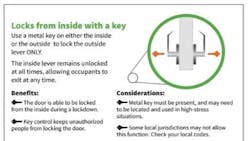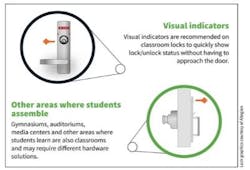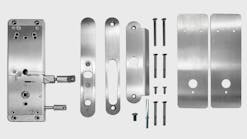
School safety and security concerns are on the rise for students, teachers and parents. A 2022 Gallup poll found that 44 percent of parents of K-12 students fear for their child’s physical safety at school. These numbers peaked in correlation with school shootings, the highest being 55 percent directly after the Columbine High School shooting. One in 5 parents also reported their child expressed fear for their safety at school.
While these numbers are alarming, school shootings are anything but common and should not be the only concern for parents, students and school staff. When panic is created around such tragic events, schools may take measures that are rushed and potentially unsafe. Administrators should also consider weather-related emergencies, fires, bomb threats, bullying, vandalism and other possible non-fatal incidents when choosing and assessing their school’s safety components and procedures. The goal is safety for every student and staff member, in every situation, every day.
The traditional approach to classroom security
One approach for school safety can be as simple as a locked door. Security experts and PASS, the Partner Alliance for Safer Schools, agree that classroom doors should be closed and locked whenever students are in the classroom. A school lockdown during an active shooter incident at Rancho Tehama School helped save the lives of every student and staff member. Doors locked from the inside should allow free egress in emergencies and must be accessible in alignment with national accessibility standards.
The traditional classroom function lock was designed in a way that only allows the door to be locked and unlocked from the outside with a key, and no locking function on the inside handle. The lock may be placed in “passage mode,” which allows it to remain unlocked on the outside. In the event of a lockdown, a keyholder would need to open the door to lock it, potentially exposing the classroom to danger.
Another common approach to classroom security is the storeroom function lock. Unlike the traditional classroom lock function, this lock, was designed to always be locked, where a keyholder must be present to allow passage through the door. This type of function leaves no room for error in a lockdown but can create disruptions to the school day where frequent egress is needed, and the lock can’t function without a keyholder present.
In this article, we’ll explore why the traditional classroom function and storeroom function locks are no longer recommended to support the current classroom environment in schools. Instead, there are three improved alternatives aiming to balance security and convenience for students and staff, from daily security concerns to emergency lockdown situations.
Classroom and Storeroom Locks
Traditional classroom function and storeroom function locks that limit locking and unlocking control to staff no longer meet all current best practice guidelines for school security. Those guidelines include:
- Ability to quickly secure the door from inside the room by any occupant in an emergency;
- Solutions that meet the Americans with Disabilities Act of 1990 (ADA) and fire and life safety codes;
- Ability to quickly and easily gain entry from outside the room by authorized school personnel or first responders with keys or credentials; and
- Visual indicators to show locked or unlocked status.
Traditional Classroom Function
The main reason traditional classroom function locks are no longer best practice for classroom doors is they require staff to open the door and potentially expose themselves to danger during emergency lockdown. The locking function only operates from the exterior side. Additionally, a keyholder must be present and able to quickly access keys to lock the door. This may result in the loss of precious minutes that can make all the difference in emergency situations. Students may be alone in the classroom during an emergency. Without access to a key, they cannot lock the door.
Since it can be disruptive to continually let students into the classroom while the door is closed and locked, a staff member may decide to keep the door in passage mode, which allows it to be unlocked all the time. Unfortunately, this means that unauthorized people can also enter the classroom, unless the teacher is able to reach the exterior of the door and lock it in time during an emergency. This use of passage mode also goes against the guidelines to keep the door locked when students are in the classroom.
Storeroom Function
Like the traditional classroom function lock, the storeroom function lock is always locked on the outside and allows free egress from the inside. However, unlike the aforementioned lock function, there is no passage mode to allow entry. Instead, someone from the inside of the classroom must let people in each time they approach the door. This makes it tempting for schools to use door props or aftermarket frame magnets to create a makeshift “passage mode” to keep the door unlocked, both of which may not align with best practices.
In a recent event, frame magnets were one of the ways many teachers prevented doors from locking so that students could go in and out freely, despite school and district policies to keep doors closed and locked at all times. Some teachers reported they only used magnets temporarily, while others stated keeping track of the key was inconvenient.
For example, as noted in the 2022 Interim Report by the Investigative Committee on the Robb Elementary Shooting, teachers would remove magnets and lock the doors only when the school district’s police officers would do routine checks to ensure the school complied with policies. Additionally, the use of magnets keeps the latch bolt from extending, which may weaken the latch springs over time and negatively impact the performance of the lock.
Improved Options for Classroom Security
Classroom security function
Unlike the traditional classroom lock, the classroom security function is locked from the inside of the classroom with a key. Teachers do not have to exit the classroom in order to lock the outside lever; the locking function can be accessed from both sides. The inside lever always remains unlocked to allow free egress as required by code.
Since the door doesn’t have to be opened to access the locking function, this style of lock allows for a safer method to lock than the traditional classroom lock. And since the locking function is controlled only by a key, there is less risk for unauthorized people to lock the door. This can help deter bullying, vandalism or other behavior that may occur when a student is able to lock the door.
However, this function isn’t without its drawbacks. Since a metal key must be used to lock the door, a keyholder must always be present and able to access the key and lock in time. It can be difficult to secure the classroom in the event of an emergency, especially if students are alone in the classroom for any reason and do not have access to a key.
Some jurisdictions may not allow this door function. When weighing your choices, consult your local codes.
Entrance/Office function
The entrance/office function lock is versatile and important for emergency lockdowns. It can be used on several different types of interior doors, but in a classroom setting it can make a huge difference in emergencies.
In addition to a keyed outside lever, a thumb turn or push button on the inside can lock or unlock the outside lever. This means the door can be easily locked by anyone close to the door; the keyholder doesn’t have to be present. The inside lever is unlocked and allows free egress regardless of the locked status.
Because the door is freely locked from the inside by anyone, not just the keyholder, quicker actions can be taken in lockdown emergencies, if someone can access the door to press the lock button or turn the thumb turn. Keys for substitute teachers don’t necessarily need to be provided so long as a staff member is able to let the substitute in.
Since anyone inside of the room can easily lock the door, it’s important to consider the associated drawbacks. Students may take advantage of this feature, creating the opportunity for student-led violence, vandalism and other mischief provided they can lock themselves in the room—and the teacher or staff member may not have access to the key. However, it’s important to note that with the right training, according to the Safe and Sound Schools safety toolkit, students as young as 4th grade are empowered to act during emergencies.
Electronic locks
Electronic locks are arguably the choice with the most benefits — albeit the more costly option. Although available funding does play a large role in security decisions, weigh the added benefits, not just the cost. You may consider integrating electronic locks with other recommended lock functions.
When used on classroom doors and tied into a centralized access control system, electronic locks provide a streamlined lockdown procedure within seconds. Classroom occupants do not need a key or even need to be near the door for it to lock. Instead, the lock is controlled remotely. All connected doors can lock in seconds with a central command and notifications alerting a lockdown can be issued to staff. These locks are also useful in areas that can benefit from being on a schedule, like a locker room. Of course, the inside lever always remains unlocked, allowing free egress.
Additionally, electronic locks provide greater monitoring ability, leaving less room for error. Real-time monitoring can confirm whether each door is closed, latched and locked. Any door connected to an electronic lock will be visible in a centralized system and help to control unauthorized access.
Finally, staff no longer need to worry about issuing or keeping track of keys to their classrooms. Instead, credential technology allows instant management of who may access each door and when. Cards, fobs and PIN access can all be used with electronic locks. Substitutes can be issued a temporary card or other credential. If a physical credential is lost, it can be instantly shut off in case it falls into the wrong hands. Access history may also be helpful in knowing exactly who accessed a certain room and when, possibly preventing vandalism or other unauthorized activities.
Indicator Locks
Indication is an important detail in classroom security when every second counts. Visual indicators show whether a door is locked or unlocked in real time. This may be in the form of arrows to show which way the key should be turned to secure the door, or real-time locking status that changes when the lock is turned such as LED lights or placards. Indicators can help avoid confusion during panic in emergency situations, and depending on the type of indicator, provide information on the lock status without approaching the door.
If budget is tight, indicators may be an initial way to begin upgrading security. Depending on the manufacturer, indication may be able to be added to current locksets using a conversion kit. This provides a low-cost option for classroom security.
Key Takeaways
Traditional classroom and storeroom locks are no longer being viewed as the recommended solution for classroom security because they do not meet best practices for school security or student safety. Instead, consider alternative and improved options—classroom security locks, entrance/office function locks and electronic locks. While each type comes with its advantages and potential drawbacks, it’s important to consider individual needs.
Be sure to consult local codes and jurisdictions. Don’t rush to increase security and, in turn, make decisions that could have unintended consequences. Take time to balance convenience with the ultimate goal of safety for every student and staff member, in every situation, every day.
Ken Cook, BSME, MBA, CPD, is Director of National School Safety and Advocacy, Allegion. In addition to leading Allegion’s efforts in assisting school districts, Cook serves on the Advisory Council for the Partner for Safer Schools Alliance (PASS) technical committee and chairs the Outreach Committee, and on the Security Industry Association (SIA) school safety committee.






